
|
Now it is bright as 6.2 mag (June 24, Marco Goiato). It keeps 6-7 mag until mid July. In the Southern Hemisphere, it keeps observable in excellent condition after this. In the Northern Hemisphere, it locates low in the south.
Date(TT) R.A. (2000) Decl. Delta r Elong. m1 Best Time(A, h)
June 25 18 49.62 -48 25.9 0.652 1.628 154 6.2 0:44 ( 0, 77)
July 2 16 56.48 -48 4.4 0.742 1.688 146 6.6 22:06 ( 0, 77)
|
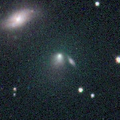
|
Now it is 11.6 mag (June 9, Marco Goiato). It keeps 11-12 mag until September. In the Northern Hemisphere, it will be getting lower gradually after this. In the Southern Hemisphere, it keeps observable in good condition for a long time.
Date(TT) R.A. (2000) Decl. Delta r Elong. m1 Best Time(A, h)
June 25 12 25.60 3 29.2 1.206 1.589 90 11.4 18:27 (173, 52)
July 2 12 37.63 0 59.4 1.238 1.574 87 11.4 18:29 (166, 53)
|

|
Now it is 11.6 mag (June 8, Chris Wyatt). It will be fading slowly after this. In the Northern Hemisphere, it will be getting lower gradually and will be unobservable in August. It is observable in the evening sky also in the Southern Hemisphere until August.
Date(TT) R.A. (2000) Decl. Delta r Elong. m1 Best Time(A, h)
June 25 11 13.70 26 4.9 3.332 3.075 66 11.6 18:27 (158, 26)
July 2 11 18.28 23 48.6 3.475 3.130 62 11.8 18:29 (151, 25)
|

|
Now it is 11.3 mag (June 10, Hiroshi Abe). It keeps 11 mag until summer. In the Northern Hemisphere, it will be unobservable soon. It locates somewhat low in the Southern Hemisphere, but it keeps observable until August.
Date(TT) R.A. (2000) Decl. Delta r Elong. m1 Best Time(A, h)
June 25 9 18.74 16 46.7 2.194 1.612 43 11.6 18:27 (128, 19)
July 2 9 38.34 15 21.7 2.216 1.603 41 11.7 18:29 (125, 19)
|

|
It will brighten up to 11 mag from summer to autumn. However, it was faint as 18.2 mag in February (Feb. 17, Alexander Baransky), fainter than this ephemeris by 2 mag. Now it is appearing in the morning sky, but it keeps low for some time.
Date(TT) R.A. (2000) Decl. Delta r Elong. m1 Best Time(A, h)
June 25 3 56.34 25 38.4 2.260 1.495 31 12.2 5:37 (233, 6)
July 2 4 21.38 25 56.5 2.213 1.464 32 12.0 5:38 (232, 6)
|

|
Now it is 12.6 mag (June 3, Giuseppe Pappa). It keeps 12-13 mag for a long time from 2015 autumn to 2016 summer. In the Northern Hemispehre, it keeps observable in good condition for a long time. It keeps unobservable until July in the Southern Hemisphere.
Date(TT) R.A. (2000) Decl. Delta r Elong. m1 Best Time(A, h)
June 25 15 29.70 58 35.5 2.689 2.893 91 12.6 21:13 (180, -3)
July 2 15 20.53 54 59.8 2.727 2.921 90 12.7 20:36 (180, 0)
|
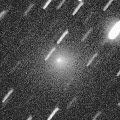
|
Now it is bright as 12.5 mag (June 6, Michael Jager). It is observable in excellent conditione in the Northern Hemisphere. It locates very low in the Southern Hemisphere. It will fade out rapidly after July.
Date(TT) R.A. (2000) Decl. Delta r Elong. m1 Best Time(A, h)
June 25 17 52.00 50 23.6 1.116 1.704 106 13.0 23:29 (180, 5)
July 2 16 51.41 44 33.1 1.165 1.763 107 13.5 22:04 (180, 11)
|

|
It brightened up to 14 mag in minor outburst in early June. But it is faint as 16.5 mag now (June 24, Jean-Francois Soulier). It is observable in excellent condition in the Southern Hemisphere.
Date(TT) R.A. (2000) Decl. Delta r Elong. m1 Best Time(A, h)
June 25 19 44.82 -25 35.5 4.963 5.926 159 13.3 1:32 (180, 81)
July 2 19 41.52 -25 39.7 4.930 5.924 166 13.3 1:02 (180, 81)
|
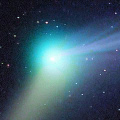
|
Now it is 13.4 mag (May 22, Ken-ichi Kadota). It brightened up to 6 mag from autumn to winter. Now it is fading. It is not observable after this in the Southern Hemisphere. It will be extremely low from May to June also in the Northern Hemisphere.
Date(TT) R.A. (2000) Decl. Delta r Elong. m1 Best Time(A, h)
June 25 5 36.45 46 59.9 4.299 3.404 24 13.5 5:37 (228,-23)
July 2 5 41.64 47 13.0 4.356 3.484 27 13.6 5:38 (225,-19)
|
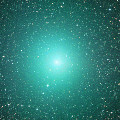
|
It passed only 0.036 a.u. from the earth on Mar. 21-22, and brightened up to 3.9 mag (Mar. 21, Thomas Lehmann). It kept brightening even after the perihelion passage. However, it is fading rapidly now. It has already faded down to 12.6 mag (June 5, Alan Hale). It keeps observable in excellent condition for a while after this both in the Northern Hemisphere and Southern Hemisphere.
Date(TT) R.A. (2000) Decl. Delta r Elong. m1 Best Time(A, h)
June 25 16 35.21 1 48.7 0.713 1.651 144 13.5 22:19 (180, 53)
July 2 16 35.44 0 15.6 0.801 1.714 140 14.3 21:52 (180, 55)
|
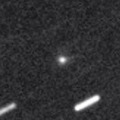
|
Now it is 14.4 mag (June 8, Chris Wyatt). It will be observable at 14 mag in good condition from spring to summer.
Date(TT) R.A. (2000) Decl. Delta r Elong. m1 Best Time(A, h)
June 25 21 16.02 -11 0.9 1.641 2.470 135 14.0 3:03 (180, 66)
July 2 21 16.02 -11 13.9 1.599 2.481 142 14.0 2:36 (180, 66)
|

|
It is not observable now. It will be observable at 16.5 mag in September in the Northern Hemisphere, or in November in the Southern Hemisphere.
Date(TT) R.A. (2000) Decl. Delta r Elong. m1 Best Time(A, h)
June 25 6 26.76 18 43.5 2.991 1.981 5 14.2 18:27 (104,-14)
July 2 6 44.56 18 38.5 2.996 1.984 4 14.2 5:38 (258,-16)
|

|
It will brighten up to 13 mag in summer. But it keeps unobservable for a long time. It will appear in the morning sky in December, when the comet will be fainter than 15 mag.
Date(TT) R.A. (2000) Decl. Delta r Elong. m1 Best Time(A, h)
June 25 6 26.97 17 30.4 2.684 1.678 6 14.4 18:27 (103,-13)
July 2 6 48.42 16 57.2 2.635 1.628 6 14.2 18:29 (101,-14)
|

|
Now it is 14.0 mag (June 10, Hiroshi Abe). Distant object, but it keeps observable at 14-15 mag for a long time from 2015 to 2016.
Date(TT) R.A. (2000) Decl. Delta r Elong. m1 Best Time(A, h)
June 25 0 36.52 2 26.3 4.883 4.888 84 14.3 5:37 (198, 51)
July 2 0 40.28 2 29.5 4.782 4.890 90 14.3 5:38 (189, 52)
|

|
It brightened rapidly up to 13.8 mag (June 8, Hidetaka Sato). It will be observable at 12-13 mag until autumn.
Date(TT) R.A. (2000) Decl. Delta r Elong. m1 Best Time(A, h)
June 25 13 8.65 -13 31.6 1.631 2.163 107 14.5 18:54 (180, 69)
July 2 13 15.77 -13 10.7 1.684 2.142 102 14.3 18:33 (180, 68)
|
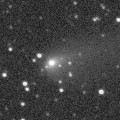
|
Now it is 13.2 mag (June 3, Giuseppe Pappa). It keeps 13 mag for a while. It is observable in excellent condition in the Southern Hemisphere. But it locates somewhat low in the Northern Hemisphere.
Date(TT) R.A. (2000) Decl. Delta r Elong. m1 Best Time(A, h)
June 25 15 17.96 -22 29.2 1.606 2.466 139 14.3 21:02 (180, 78)
July 2 15 18.19 -22 27.8 1.684 2.488 132 14.5 20:35 (180, 78)
|

|
It became so bright as 8 mag in 2009. In the Northern Hemispehre, it will appear in the morning sky in July, then it will be observable at 11-12 mag from summer to autumn. In the Southern Hemisphere, it keeps extremely low for a long time until autumn.
Date(TT) R.A. (2000) Decl. Delta r Elong. m1 Best Time(A, h)
June 25 4 35.89 22 27.4 2.502 1.616 23 15.0 5:37 (241, 1)
July 2 4 58.70 22 55.4 2.451 1.582 24 14.4 5:38 (240, 2)
|

|
Now it is 16.0 mag (May 14, Hidetaka Sato), brighter than originally predicted. It will brighten up to 14 mag in summer. In the Southern Hemisphere, it keeps observable until winter, but it locates somewhat low. In the Northern Hemisphere, it is not observable now. It will appear in the morning sky in July, then it will be observable in excellent condition.
Date(TT) R.A. (2000) Decl. Delta r Elong. m1 Best Time(A, h)
June 25 3 0.07 3 34.0 1.828 1.431 51 14.5 5:37 (239, 31)
July 2 3 19.79 6 3.0 1.808 1.430 52 14.4 5:38 (235, 31)
|

|
Now it is bright as 13.7 mag (June 3, Giuseppe Pappa). In the Northern Hemisphere, it will be getting lower gradually after this, and it will be unobservable in late July. In the Southern Hemisphere, it keeps observable in good condition until autumn. But it will be fading slowly after this.
Date(TT) R.A. (2000) Decl. Delta r Elong. m1 Best Time(A, h)
June 25 12 40.09 -20 31.8 1.903 2.355 103 14.7 18:27 (178, 76)
July 2 12 45.56 -21 28.5 1.988 2.361 98 14.8 18:29 (155, 75)
|

|
New comet discovered from the STEREO spacecraft images in May. It brightened up to 8 mag due to the forward scattering. In the Southern Hemisphere, it is appearing in the evening sky, and it will be getting higher rapidly. It it not observable in the Northern Hemisphere.
Date(TT) R.A. (2000) Decl. Delta r Elong. m1 Best Time(A, h)
June 25 9 7.40 -0 56.4 1.126 0.881 48 14.7 18:27 (112, 30)
July 2 9 52.25 -4 40.6 1.172 0.994 53 15.3 18:29 (112, 35)
|
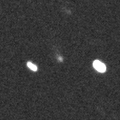
|
Now it is bright as 14.9 mag (May 4, Hidetaka Sato). It keeps 15 mag until autumn. In the Southern Hemisphere, it keeps observable for a long time. It will be unobservable after this in the Northern Hemisphere.
Date(TT) R.A. (2000) Decl. Delta r Elong. m1 Best Time(A, h)
June 25 6 22.56 -44 3.3 2.486 2.297 67 14.9 18:27 ( 50, 21)
July 2 6 44.52 -46 13.8 2.455 2.301 69 14.9 5:38 (313, 21)
|
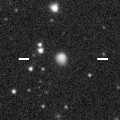
|
Now it is 14.6 mag (June 10, Artyom Novichonok). It is expected to brighten up to 7 mag in 2017 summer. In the Northern Hemisphere, it becomes low temporarily in summer, but it keeps observable in good condition until the highlight while the comet will be brightening. In the Southern Hemisphere, it is not observable until early 2017.
Date(TT) R.A. (2000) Decl. Delta r Elong. m1 Best Time(A, h)
June 25 8 13.03 55 20.2 5.179 4.430 38 15.0 18:27 (147,-17)
July 2 8 24.28 54 52.8 5.136 4.365 36 15.0 18:29 (145,-19)
|
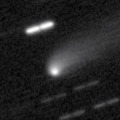
|
It brightened very rapidly in 2015 spring, and reached up to 13.8 mag (2015 May 11, Sandor Szabo). Now it is 15.7 mag (June 7, Yasukazu Ikari). It is observable in excellent condition in the Southern Hemisphere. But it locates somewhat low in the Northern Hemisphere.
Date(TT) R.A. (2000) Decl. Delta r Elong. m1 Best Time(A, h)
June 25 13 41.79 -25 27.6 3.787 4.361 118 16.0 19:26 (180, 81)
July 2 13 43.55 -25 10.7 3.905 4.391 112 16.1 19:01 (180, 80)
|
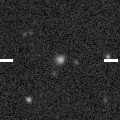
|
Now it is 16.6 mag (June 6, P. C. Sherrod, L. P. Sherrod). It is expected to brighten up to 7 mag in 2017 spring. But it locates somewhat low at the high light.
Date(TT) R.A. (2000) Decl. Delta r Elong. m1 Best Time(A, h)
June 25 11 12.03 -0 11.3 4.467 4.326 75 16.1 18:27 (144, 49)
July 2 11 15.03 -0 20.5 4.501 4.254 69 16.1 18:29 (135, 46)
|
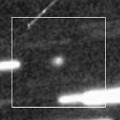
|
Now it is 16.8 mag (June 3, Yasukazu Ikari). It will be observable at 13 mag for a long time from 2017 to 2018. In 2016, it keeps observable at 16-17 mag in good condition until autumn.
Date(TT) R.A. (2000) Decl. Delta r Elong. m1 Best Time(A, h)
June 25 19 50.26 -11 18.7 5.364 6.297 154 16.4 1:38 (180, 66)
July 2 19 43.79 -11 3.6 5.281 6.253 161 16.4 1:04 (180, 66)
|
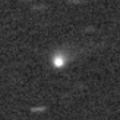
|
Now it is 16.4 mag (June 5, Yasukazu Ikari). It will be getting lower after this, and will be unobservable in August. It will brighten up to 14 mag in 2017. The perihelion distance increases from 2.4 a.u. to 2.9 a.u. in this apparition, and the comet will not brighten as before.
Date(TT) R.A. (2000) Decl. Delta r Elong. m1 Best Time(A, h)
June 25 11 34.74 10 50.1 3.743 3.641 76 16.4 18:27 (158, 42)
July 2 11 39.37 10 2.4 3.824 3.625 71 16.4 18:29 (150, 40)
|
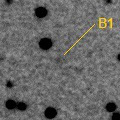
|
Now it is bright as 17.3 mag (June 2, Yasukazu Ikari). It keeps 16 mag for a long time from 2016 to 2017. In 2016, it is observable in excellent condition in the Southern Hemisphere, but it locates extremely low in the Northern Hemispehre.
Date(TT) R.A. (2000) Decl. Delta r Elong. m1 Best Time(A, h)
June 25 12 17.34 -27 52.2 3.222 3.558 100 16.6 18:27 (142, 81)
July 2 12 23.32 -26 32.7 3.283 3.530 95 16.5 18:29 (126, 77)
|
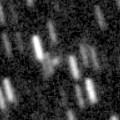
|
Now it is 17.0 mag (Feb. 7, iTelescope Observatory, Siding Spring). It keeps 16.5 mag for a long time in 2016, and it will be observable in excellent condition in the Southern Hemisphere. It is hardly observable in the Northern Hemisphere.
Date(TT) R.A. (2000) Decl. Delta r Elong. m1 Best Time(A, h)
June 25 3 44.86 -37 25.4 3.604 3.401 70 16.6 5:37 (291, 44)
July 2 3 44.84 -37 58.9 3.544 3.411 74 16.6 5:38 (290, 49)
|
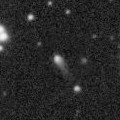
|
Now it is 16.5 mag (June 16, J. Camarasa). It keeps 16.5 mag from 2016 to 2017. It is observable in good condition in the Northern Hemisphere. In the Southern Hemisphere, it locates low in 2016, and it is not observable in 2017.
Date(TT) R.A. (2000) Decl. Delta r Elong. m1 Best Time(A, h)
June 25 16 51.39 35 4.7 5.807 6.351 118 16.7 22:35 (180, 20)
July 2 16 47.27 35 23.2 5.841 6.343 115 16.7 22:03 (180, 20)
|

|
First return of a new periodic comet which brightened up to 16.5 mag in 2008. The condition of this apparition is very good. It is expected to brighten up to 15.5 mag in autumn and will be observable in good condition.
Date(TT) R.A. (2000) Decl. Delta r Elong. m1 Best Time(A, h)
June 25 0 12.14 -20 20.8 2.178 2.540 98 16.8 5:37 (199, 75)
July 2 0 17.78 -19 44.3 2.080 2.520 103 16.7 5:37 (180, 75)
|
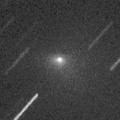
|
First return of an object discovered as an asteroid 2007 VA85 in 2007. It brightened very rapidly since mid February, and brightened up to 11.3 mag in spring (Mar. 5, Juan Jose Gonzalez). Now it is fading. It has already faded down to 16.1 mag (June 9, Hidetaka Sato). It keeps unobservable until September in the Southern Hemisphere.
Date(TT) R.A. (2000) Decl. Delta r Elong. m1 Best Time(A, h)
June 25 2 28.25 52 44.4 1.973 1.562 51 16.8 5:37 (203, -4)
July 2 2 15.52 54 51.5 1.906 1.623 58 17.2 5:38 (196, -3)
|

|
It brightened up to 3.7 mag and became a naked eye comet in mid January in 2015 (Jan. 13, Marek Biely). Now it is fading. It has already faded down to 15.6 mag (June 13, Catalina Sky Survey). In the Northern Hemisphere, it keeps observable for a long time until the comet fades out. It locates somewhat low in the Southern Hemisphere.
Date(TT) R.A. (2000) Decl. Delta r Elong. m1 Best Time(A, h)
June 25 17 42.42 25 54.1 5.300 6.004 130 16.8 23:26 (180, 29)
July 2 17 37.31 25 19.5 5.375 6.066 128 16.9 22:53 (180, 30)
|
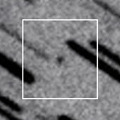
|
It will brighten up to 15 mag in summer. It is observable in excellent condition in the Northern Hemispehre. In the Southern Hemisphere, it keeps locating low until August, but it will be observable in good condition after September.
Date(TT) R.A. (2000) Decl. Delta r Elong. m1 Best Time(A, h)
June 25 1 52.70 39 51.7 2.412 2.046 57 17.0 5:37 (203, 10)
July 2 1 47.19 40 54.6 2.247 2.015 63 16.8 5:38 (197, 11)
|
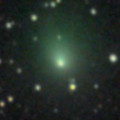
|
It brightened up to 10 mag in 2015 autumn. Now it is appearing in the morning sky, but it must be already fainter than 16 mag.
Date(TT) R.A. (2000) Decl. Delta r Elong. m1 Best Time(A, h)
June 25 2 42.79 11 37.8 3.194 2.688 51 16.8 5:37 (229, 28)
July 2 2 51.59 12 10.8 3.159 2.729 56 17.0 5:38 (225, 31)
|

|
Appearing in the morning sky. It will be observable at 16 mag in good condition from autumn to winter. It locates somewhat low in the Southern Hemisphere.
Date(TT) R.A. (2000) Decl. Delta r Elong. m1 Best Time(A, h)
June 25 2 30.84 19 10.5 3.005 2.515 52 16.9 5:37 (222, 24)
July 2 2 42.83 20 23.9 2.937 2.512 55 16.8 5:38 (217, 25)
|

|
Now it is 17.1 mag (June 14, Mt. Lemmon Survey). It will brighten up to 16.5 mag in summer and will be observable in good condition.
Date(TT) R.A. (2000) Decl. Delta r Elong. m1 Best Time(A, h)
June 25 17 56.55 -11 51.2 1.812 2.813 167 16.9 23:40 (180, 67)
July 2 17 51.07 -11 30.2 1.804 2.791 162 16.9 23:07 (180, 66)
|
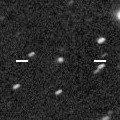
|
Now it is 17.0 mag (June 16, Catalina Sky Survey). It brightened rapidly, and became brighter than originally expected. It keeps 17 mag until 2017. It is observable in excellent condition in the Northern Hemisphere. It is not observable in the Southern Hemisphere.
Date(TT) R.A. (2000) Decl. Delta r Elong. m1 Best Time(A, h)
June 25 13 19.25 70 19.5 7.510 7.281 73 16.9 19:03 (180,-15)
July 2 13 12.70 69 10.7 7.547 7.279 70 16.9 18:29 (180,-14)
|
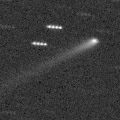
|
It brightened up to 15 mag from late 2014 to early 2016. Now it is fading slowly. Now it is 16.6 mag (June 16, Catalina Sky Survey). In the Northern Hemisphere, it will be observable at 17 mag in autumn in good condition. It locates extremely low in the Southern Hemisphere.
Date(TT) R.A. (2000) Decl. Delta r Elong. m1 Best Time(A, h)
June 25 0 15.51 37 14.2 4.979 4.838 76 16.9 5:37 (185, 17)
July 2 0 11.26 38 25.8 4.901 4.866 82 16.9 5:30 (180, 17)
|
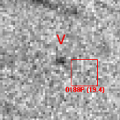
|
It is expected to brighten up to 16 mag and observable in good condition in autumn. However, it is so faint as 19.7 mag now (Apr. 16, A. Maury, J.-B. de Vanssay, J.-G. Bosch, J.-F. Soulier).
Date(TT) R.A. (2000) Decl. Delta r Elong. m1 Best Time(A, h)
June 25 23 13.57 -12 31.3 2.524 3.013 109 17.0 5:00 (180, 67)
July 2 23 16.50 -12 11.4 2.416 2.990 114 16.9 4:36 (180, 67)
|
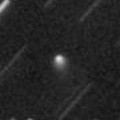
|
Now it is 16.7 mag (June 12, Mt. Lemmon Survey). It keeps brightening even after the perihelion passage. It keeps observable at 17 mag in good condition until autumn.
Date(TT) R.A. (2000) Decl. Delta r Elong. m1 Best Time(A, h)
June 25 14 36.27 7 30.7 6.048 6.589 118 17.0 20:20 (180, 48)
July 2 14 34.49 7 53.5 6.171 6.610 111 17.1 19:51 (180, 47)
|

|
It brightened up to 13-14 mag from 2014 to 2015. Now it is fading. It has already faded down to 16.6 mag (June 5, Space Surveillance Telescope, Atom Site). It will be observable at 17 mag in 2016.
Date(TT) R.A. (2000) Decl. Delta r Elong. m1 Best Time(A, h)
June 25 23 25.61 -2 40.4 4.930 5.247 102 17.3 5:12 (180, 58)
July 2 23 26.56 -2 42.1 4.870 5.290 109 17.3 4:46 (180, 58)
|

|
Now it is 17.5 mag (June 3, iTelescope SRO Observatory, Auberry). It keeps 17-18 mag until autumn. It keeps observable in excellent condition in the Northern Hemisphere. It will be getting lower gradually in the Southern Hemisphere.
Date(TT) R.A. (2000) Decl. Delta r Elong. m1 Best Time(A, h)
June 25 23 8.01 9 2.1 1.870 2.302 101 17.5 4:55 (180, 46)
July 2 22 58.26 12 54.1 1.763 2.296 108 17.3 4:18 (180, 42)
|
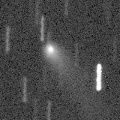
|
It was observed at 14-15 mag from 2014 to 2015. Now it is fading. In the Northern Hemisphere, it keeps observable in excellent condition until winter when the comet will be fainter than 18 mag. It is not observable in the Southern Hemisphere.
Date(TT) R.A. (2000) Decl. Delta r Elong. m1 Best Time(A, h)
June 25 3 18.69 63 34.0 6.145 5.541 49 17.4 5:37 (202,-17)
July 2 3 28.17 64 45.1 6.143 5.580 52 17.4 5:38 (199,-16)
|

|
Now it is 18.3 mag (June 8, B. Lutkenhoner). It will brighten up to 16 mag and will be observable in good condition in 2017. In 2016, it is observable in excellent condition in the Southern Hemisphere, but it keeps low in the Northern Hemisphere.
Date(TT) R.A. (2000) Decl. Delta r Elong. m1 Best Time(A, h)
June 25 19 17.18 -40 11.1 2.433 3.400 158 17.5 1:05 ( 0, 85)
July 2 19 11.26 -40 22.7 2.401 3.381 161 17.4 0:32 ( 0, 85)
|

|
It was observed as bright as 13-14 mag for a long time from 2011 to 2014. Now it is fading. It is observable in excellent condition in the Southern Hemisphere. It locates extremely low in the Northern Hemisphere. No observations have been reported since August, 2015.
Date(TT) R.A. (2000) Decl. Delta r Elong. m1 Best Time(A, h)
June 25 17 26.83 -37 16.7 8.653 9.628 162 17.4 23:10 ( 0, 88)
July 2 17 22.16 -37 23.7 8.717 9.662 157 17.5 22:38 ( 0, 88)
|
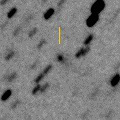
|
It brightened rapidly up to 15.1 mag in May (May 12, Yuji Ohshima). Now it is fading rapidly. It has already faded down to 17.3 mag (June 2, Yasukazu Ikari). It is observable in excellent condition in the Southern Hemisphere. It locates low in the Northern Hemisphere.
Date(TT) R.A. (2000) Decl. Delta r Elong. m1 Best Time(A, h)
June 25 14 38.45 -40 43.1 1.296 2.112 131 17.6 20:23 ( 0, 84)
July 2 14 38.69 -41 9.9 1.367 2.129 125 17.8 19:56 ( 0, 84)
|
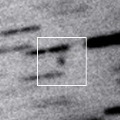
|
Now it is 17.7 mag (June 12, B. Lutkenhoner). It keeps observable at 17.5 mag in good condition from spring to autumn in the Southern Hemisphere. It is not observable in the Northern Hemisphere.
Date(TT) R.A. (2000) Decl. Delta r Elong. m1 Best Time(A, h)
June 25 17 52.68 -64 24.9 4.196 5.006 138 17.6 23:37 ( 0, 61)
July 2 17 47.48 -64 11.2 4.199 4.999 137 17.6 23:04 ( 0, 61)
|

|
It has not been observed in this apparition yet. It will brighten up to 17.5 mag in summer.
Date(TT) R.A. (2000) Decl. Delta r Elong. m1 Best Time(A, h)
June 25 20 42.44 -17 54.4 2.264 3.154 145 17.8 2:30 (180, 73)
July 2 20 39.71 -17 60.0 2.208 3.146 152 17.7 2:00 (180, 73)
|

|
Although it was bright as 17 mag at the discovery in 2006, it faded out before the perihelion passage in 2008, and it became lost. Now it is fainter than 19 mag (May 30, Jean-Francois Soulier).
Date(TT) R.A. (2000) Decl. Delta r Elong. m1 Best Time(A, h)
June 25 15 28.43 5 35.3 3.735 4.456 129 17.8 21:12 (180, 49)
July 2 15 26.49 5 6.1 3.800 4.449 124 17.9 20:43 (180, 50)
|
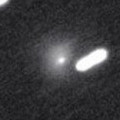
|
Very far object. Outburst occured on Feb. 20, 2015, and it brightened up to 15 mag. Now it is 17.8 mag (June 4, Space Surveillance Telescope, Atom Site). It is observable in excellent condition in the Southern Hemisphere. It locates somewhat low in the Northern Hemisphere.
Date(TT) R.A. (2000) Decl. Delta r Elong. m1 Best Time(A, h)
June 25 13 10.99 -22 21.5 8.791 9.199 110 17.9 18:56 (180, 77)
July 2 13 11.64 -22 8.8 8.898 9.202 104 17.9 18:29 (179, 77)
|

|
Now it is 17.6 mag (May 29, K. Hills). It was expected to brighten up to 14 mag from winter to summer. But it is much fainter actually. It will be observable in excellent condition in the Southern Hemisphere. It locates low in the Northern Hemisphere.
Date(TT) R.A. (2000) Decl. Delta r Elong. m1 Best Time(A, h)
June 25 16 6.04 -39 54.5 1.956 2.869 148 18.4 21:50 ( 0, 85)
July 2 16 4.91 -39 40.7 2.044 2.917 142 18.6 21:22 ( 0, 85)
|
|
![]()
 C/2014 W2 ( PanSTARRS )
C/2014 W2 ( PanSTARRS ) C/2015 WZ ( PanSTARRS )
C/2015 WZ ( PanSTARRS ) 29P/Schwassmann-Wachmann 1
29P/Schwassmann-Wachmann 1 C/2013 US10 ( Catalina )
C/2013 US10 ( Catalina ) 252P/LINEAR
252P/LINEAR 53P/Van Biesbroeck
53P/Van Biesbroeck 118P/Shoemaker-Levy 4
118P/Shoemaker-Levy 4 C/2015 TQ209 ( LINEAR )
C/2015 TQ209 ( LINEAR ) C/2011 KP36 ( Spacewatch )
C/2011 KP36 ( Spacewatch ) 237P/LINEAR
237P/LINEAR 116P/Wild 4
116P/Wild 4 144P/Kushida
144P/Kushida 146P/Shoemaker-LINEAR
146P/Shoemaker-LINEAR 77P/Longmore
77P/Longmore P/2016 J3 ( STEREO )
P/2016 J3 ( STEREO ) C/2015 T4 ( PanSTARRS )
C/2015 T4 ( PanSTARRS ) C/2015 V2 ( Johnson )
C/2015 V2 ( Johnson ) C/2014 W11 ( PanSTARRS )
C/2014 W11 ( PanSTARRS ) C/2015 ER61 ( PanSTARRS )
C/2015 ER61 ( PanSTARRS ) C/2015 O1 ( PanSTARRS )
C/2015 O1 ( PanSTARRS ) 65P/Gunn
65P/Gunn C/2016 B1 ( NEOWISE )
C/2016 B1 ( NEOWISE ) C/2015 B2 ( PanSTARRS )
C/2015 B2 ( PanSTARRS ) C/2014 OE4 ( PanSTARRS )
C/2014 OE4 ( PanSTARRS ) P/2008 J3 ( McNaught )
P/2008 J3 ( McNaught ) 333P/LINEAR
333P/LINEAR C/2014 Q2 ( Lovejoy )
C/2014 Q2 ( Lovejoy ) C/2016 A8 ( LINEAR )
C/2016 A8 ( LINEAR ) 22P/Kopff
22P/Kopff 56P/Slaughter-Burnham
56P/Slaughter-Burnham 219P/LINEAR
219P/LINEAR C/2014 R3 ( PanSTARRS )
C/2014 R3 ( PanSTARRS ) C/2014 A4 ( SONEAR )
C/2014 A4 ( SONEAR ) 188P/LINEAR-Mueller
188P/LINEAR-Mueller C/2015 LC2 ( PanSTARRS )
C/2015 LC2 ( PanSTARRS ) C/2012 F3 ( PanSTARRS )
C/2012 F3 ( PanSTARRS ) C/2016 K1 ( LINEAR )
C/2016 K1 ( LINEAR ) C/2014 N3 ( NEOWISE )
C/2014 N3 ( NEOWISE ) 47P/Ashbrook-Jackson
47P/Ashbrook-Jackson C/2010 S1 ( LINEAR )
C/2010 S1 ( LINEAR ) 100P/Hartley 1
100P/Hartley 1 C/2015 H2 ( PanSTARRS )
C/2015 H2 ( PanSTARRS ) P/2008 T1 ( Boattini )
P/2008 T1 ( Boattini ) P/2006 F1 ( Kowalski )
P/2006 F1 ( Kowalski ) C/2013 C2 ( Tenagra )
C/2013 C2 ( Tenagra ) C/2014 Y1 ( PanSTARRS )
C/2014 Y1 ( PanSTARRS )![]()







































